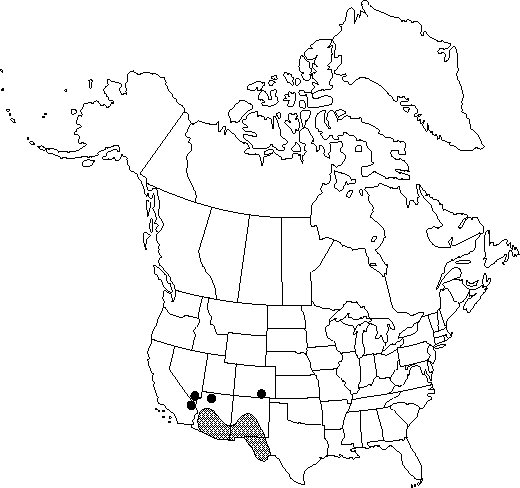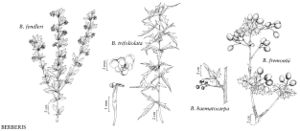Difference between revisions of "Berberis haematocarpa"
Bull. Torrey Bot. Club 25: 304. 1898.
FNA>Volume Importer |
imported>Volume Importer |
||
| (7 intermediate revisions by 2 users not shown) | |||
| Line 10: | Line 10: | ||
|special_status={{Treatment/ID/Special_status | |special_status={{Treatment/ID/Special_status | ||
|code=F | |code=F | ||
| − | |label= | + | |label=Illustrated |
}} | }} | ||
|basionyms= | |basionyms= | ||
| Line 16: | Line 16: | ||
|name=Berberis nevinii var. haematocarpa | |name=Berberis nevinii var. haematocarpa | ||
|authority=(Wooton) L. D. Benson | |authority=(Wooton) L. D. Benson | ||
| − | }}{{Treatment/ID/Synonym | + | |rank=variety |
| + | }} {{Treatment/ID/Synonym | ||
|name=Mahonia haematocarpa | |name=Mahonia haematocarpa | ||
|authority=(Wooton) Fedde | |authority=(Wooton) Fedde | ||
| + | |rank=species | ||
}} | }} | ||
|hierarchy=Berberidaceae;Berberis;Berberis haematocarpa | |hierarchy=Berberidaceae;Berberis;Berberis haematocarpa | ||
| Line 27: | Line 29: | ||
}}<!-- | }}<!-- | ||
| − | --><span class="statement" id="st- | + | --><span class="statement" id="st-undefined" data-properties=""><b>Shrubs,</b> evergreen, 1-4 m. <b>Stems</b> ± dimorphic, with elongate primary and short or somewhat elongate axillary shoots. <b>Bark</b> of 2d-year stems grayish purple, glabrous. <b>Bud</b> scales 2-4 mm, deciduous. <b>Spines</b> absent. <b>Leaves</b> 3-9-foliolate; petioles 0.1-0.5 cm. <b>Leaflet</b> blades thick and rigid; surfaces abaxially dull, papillose, adaxially dull, glaucous; terminal leaflet stalked in most leaves, blade 1.5-3.8 × 0.5-1.1 cm, 2-5 times as long as wide; lateral leaflet blades oblong-ovate to ovate or lanceolate, 1(-3)-veined from base, base acute to obtuse, rarely subtruncate, margins undulate or crispate, toothed or lobed, with 2-4 teeth 1-4 mm high tipped with spines to 1.2-2 × 0.2-0.3 mm, apex narrowly acute or acuminate. <b>Inflorescences</b> racemose, lax, 3-7-flowered, 1.5–4.5 cm; bracteoles membranous, apex acuminate. <b>Flowers</b>: anther filaments without distal pair of recurved lateral teeth. <b>Berries</b> purplish red, glaucous, spheric or short-ellipsoid, 5-8 mm, juicy, solid.</span><!-- |
-->{{Treatment/Body | -->{{Treatment/Body | ||
| Line 33: | Line 35: | ||
|habitat=Slopes and flats in desert shrubland, desert grassland, and dry oak woodland | |habitat=Slopes and flats in desert shrubland, desert grassland, and dry oak woodland | ||
|elevation=900-2300 m | |elevation=900-2300 m | ||
| − | |distribution=Ariz.;Calif.;Colo.;Nev.;N.Mex.;Tex.;Mexico (Sonora) | + | |distribution=Ariz.;Calif.;Colo.;Nev.;N.Mex.;Tex.;Mexico (Sonora). |
| − | |discussion=<p>Typical populations of Berberis haematocarpa (with narrowly ovate or lanceolate leaflets and small, juicy, deep red berries) and B. fremontii (with ovate or orbiculate leaflets and large, dry, inflated, yellowish or brownish berries) are easily distinguished. These characteristics are not always well correlated, however, and intermediate populations, showing different combinations of leaflet shape and berry size, color, and inflation, are known.</p><!-- | + | |discussion=<p>Typical populations of <i>Berberis haematocarpa</i> (with narrowly ovate or lanceolate leaflets and small, juicy, deep red berries) and <i>B. fremontii</i> (with ovate or orbiculate leaflets and large, dry, inflated, yellowish or brownish berries) are easily distinguished. These characteristics are not always well correlated, however, and intermediate populations, showing different combinations of leaflet shape and berry size, color, and inflation, are known.</p><!-- |
| − | --><p>Berberis haematocarpa is susceptible to infection by Puccinia graminis.</p> | + | --><p><i>Berberis haematocarpa</i> is susceptible to infection by Puccinia graminis.</p> |
|tables= | |tables= | ||
|references= | |references= | ||
| Line 44: | Line 46: | ||
-->{{#Taxon: | -->{{#Taxon: | ||
name=Berberis haematocarpa | name=Berberis haematocarpa | ||
| − | |||
|authority=Wooton | |authority=Wooton | ||
|rank=species | |rank=species | ||
| Line 54: | Line 55: | ||
|habitat=Slopes and flats in desert shrubland, desert grassland, and dry oak woodland | |habitat=Slopes and flats in desert shrubland, desert grassland, and dry oak woodland | ||
|elevation=900-2300 m | |elevation=900-2300 m | ||
| − | |distribution=Ariz.;Calif.;Colo.;Nev.;N.Mex.;Tex.;Mexico (Sonora) | + | |distribution=Ariz.;Calif.;Colo.;Nev.;N.Mex.;Tex.;Mexico (Sonora). |
|reference=None | |reference=None | ||
|publication title=Bull. Torrey Bot. Club | |publication title=Bull. Torrey Bot. Club | ||
|publication year=1898 | |publication year=1898 | ||
| − | |special status= | + | |special status=Illustrated |
| − | |source xml=https:// | + | |source xml=https://bitbucket.org/aafc-mbb/fna-data-curation/src/2e0870ddd59836b60bcf96646a41e87ea5a5943a/coarse_grained_fna_xml/V3/V3_544.xml |
|genus=Berberis | |genus=Berberis | ||
|species=Berberis haematocarpa | |species=Berberis haematocarpa | ||
| − | |||
| − | |||
| − | |||
| − | |||
| − | |||
| − | |||
| − | |||
| − | |||
| − | |||
| − | |||
| − | |||
| − | |||
| − | |||
| − | |||
| − | |||
| − | |||
| − | |||
| − | |||
| − | |||
| − | |||
| − | |||
| − | |||
| − | |||
| − | |||
| − | |||
| − | |||
| − | |||
| − | |||
| − | |||
| − | |||
| − | |||
| − | |||
| − | |||
| − | |||
| − | |||
| − | |||
| − | |||
| − | |||
| − | |||
| − | |||
| − | |||
| − | |||
| − | |||
| − | |||
| − | |||
}}<!-- | }}<!-- | ||
-->[[Category:Treatment]][[Category:Berberis]] | -->[[Category:Treatment]][[Category:Berberis]] | ||
Latest revision as of 21:49, 5 November 2020
Shrubs, evergreen, 1-4 m. Stems ± dimorphic, with elongate primary and short or somewhat elongate axillary shoots. Bark of 2d-year stems grayish purple, glabrous. Bud scales 2-4 mm, deciduous. Spines absent. Leaves 3-9-foliolate; petioles 0.1-0.5 cm. Leaflet blades thick and rigid; surfaces abaxially dull, papillose, adaxially dull, glaucous; terminal leaflet stalked in most leaves, blade 1.5-3.8 × 0.5-1.1 cm, 2-5 times as long as wide; lateral leaflet blades oblong-ovate to ovate or lanceolate, 1(-3)-veined from base, base acute to obtuse, rarely subtruncate, margins undulate or crispate, toothed or lobed, with 2-4 teeth 1-4 mm high tipped with spines to 1.2-2 × 0.2-0.3 mm, apex narrowly acute or acuminate. Inflorescences racemose, lax, 3-7-flowered, 1.5–4.5 cm; bracteoles membranous, apex acuminate. Flowers: anther filaments without distal pair of recurved lateral teeth. Berries purplish red, glaucous, spheric or short-ellipsoid, 5-8 mm, juicy, solid.
Phenology: Flowering winter–spring (Feb–Jun).
Habitat: Slopes and flats in desert shrubland, desert grassland, and dry oak woodland
Elevation: 900-2300 m
Distribution

Ariz., Calif., Colo., Nev., N.Mex., Tex., Mexico (Sonora).
Discussion
Typical populations of Berberis haematocarpa (with narrowly ovate or lanceolate leaflets and small, juicy, deep red berries) and B. fremontii (with ovate or orbiculate leaflets and large, dry, inflated, yellowish or brownish berries) are easily distinguished. These characteristics are not always well correlated, however, and intermediate populations, showing different combinations of leaflet shape and berry size, color, and inflation, are known.
Berberis haematocarpa is susceptible to infection by Puccinia graminis.
Selected References
None.
